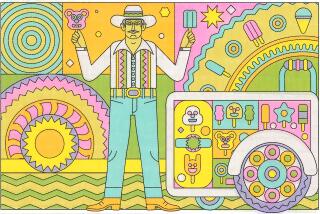Zamboni Drivers Have Coolest Jobs Around
There’s something Zen-like about watching a Zamboni, the hulking vehicle whose solemn dance is the feature of every intermission at an ice rink. There’s the drone of the machine, the driver’s look of intense concentration and the way it glides over chewed-up ice and magically leaves behind a slick, smooth surface.
Cartoonist Charles Schulz, a Minneapolis native who adored ice skating and hockey, once said: “There are three things in life people like to stare at: a flowing stream, a crackling fire and a Zamboni clearing the ice.”
Richard Zamboni, president of the Paramount-based company that makes the machines invented by his father, agreed: “It is a little bit mysterious what happens. I get fascinated myself.”
Of course, only one thing could be better than watching a Zamboni.
Driving one.
Denizens of the skating world say it’s a common fantasy of spectators at hockey games and figure skating competitions.
In homage to the Zamboni, ESPN: the Magazine declared, “Every red-blooded, beer-drinking knucklehead with a painted face wants his turn behind the wheel.”
The allure of the lumbering machine has even been immortalized in a song, “I Wanna Drive the Zamboni,” by the Gear Daddies: “Since I was young, it’s been my dream to drive that there Zamboni machine. I’d get that ice just as slick as could be, and all the kids would look up to me.”
Zamboni drivers at hockey games are often cheered and photographed. The driver for the Detroit Red Wings even gives out autographs.
When Jill LeGault, Zamboni driver for Anaheim’s Mighty Ducks, takes to the ice, “people like to yell and scream,” she said. “Some people know my name. It’s fun, it’s neat, but it’s kind of hard because you need to concentrate on what you’re doing out there.”
Indeed, even at 9 mph, the Zamboni is not exactly easy to drive.
“It’s pretty big and bulky,” LeGault said. “Some people compare it to a tractor.”
Aside from carefully steering the machine in a pattern that covers all the ice, there are also other variables to control. Drivers adjust the angle of the blade and the flow of the water, and make sure the ice shavings aren’t clumping inside the machine.
And usually, the work has to be speedy. In the 15-minute intervals between hockey periods, a Zamboni picks up about 1,500 pounds of ice shavings and leaves behind about 1,200 pounds of water.
Those aren’t the only challenges. It’s also hard to see while you’re driving. And if you make a mistake -- such as running into the boards that line the rink -- your goof might be witnessed by thousands of people.
LeGault has never crashed -- and she doesn’t really want to think about that. “I don’t want to jinx myself,” she said.
It took her a couple of months to learn. The first time she drove the Zamboni, in 1994, someone else handled all the controls.
“It’s pretty detailed,” she said. “At first, all you learn how to do is maneuver the machine. Gradually, you learn how to work water controls, blade controls. As you go on, you learn what to do when there’s different people on the ice.”
In the National Hockey League, two Zambonis usually work in tandem, making it even more difficult. There are special patterns, although LeGault joked, “We don’t do figure-8s or anything like that.”
Most of the time, LeGault, 31, doesn’t tell people she meets that she drives a Zamboni. But if they find out, they are immediately intrigued.
“People are really obsessed with it,” she said. “It’s mesmerizing to watch.”
Richard Zamboni agreed: “It really is a little strange when you get down to it,” he said of the machine’s popularity. “It was certainly something my father never envisioned.”
In the 1940s, Frank Zamboni built his first ice resurfacing machine to cut down on the time and expense of preparing the ice at his Iceland Skating Rink in Paramount.
Before the Zamboni, resurfacing was a clumsy business: A tractor tugged a scraper, shaving the ice. Three or four workers followed, scooping up the shavings, spraying water over the surface and squeegeeing it clean. The job took more than an hour.
The Model A Zamboni, which had its debut in 1949, changed all that. It’s still on display at Iceland. Zamboni kept tinkering, modifying the models for size, and how the ice shavings are moved from the rink to the dump tank.
The company also added electric and natural-gas models, but the concept has remained largely unchanged for years, said Paula Coony, general manager of the Zamboni Merchandising Co.
Legendary figure skater Sonja Henie saw the machine in action and immediately ordered two for her show. She bought the third and fourth machines ever built. Now, there are about 7,000 in operation, and the Zamboni has even found a home at the Hockey Hall of Fame in Toronto.
Schulz, the late cartoonist, gets a lot of credit for helping to popularize the machine. He built an ice rink in his adopted home of Santa Rosa and owned a Zamboni. He also featured it in more than 50 of his “Peanuts” comic strips. The Woodstock character could often be seen driving a Zamboni on his frozen birdbath.
At the Iceland rink, home to Zamboni memorabilia, fans can buy a T-shirt with Snoopy driving one of the machines. Demand for Zamboni products is so strong that the company now markets keychains, remote-controlled Zambonis and other toys. There’s even a Zamboni-shaped Monopoly token.
“It’s kind of like a mascot to some people,” Coony said. “It’s taken on a life of its own.”
Coony has fielded more than one frantic call from last-minute gift buyers asking for overnight shipping.
The callers had, after all, found the perfect gift for the Zamboni lover: a license plate frame that reads “My other car is a Zamboni.”
More to Read
Go beyond the scoreboard
Get the latest on L.A.'s teams in the daily Sports Report newsletter.
You may occasionally receive promotional content from the Los Angeles Times.







